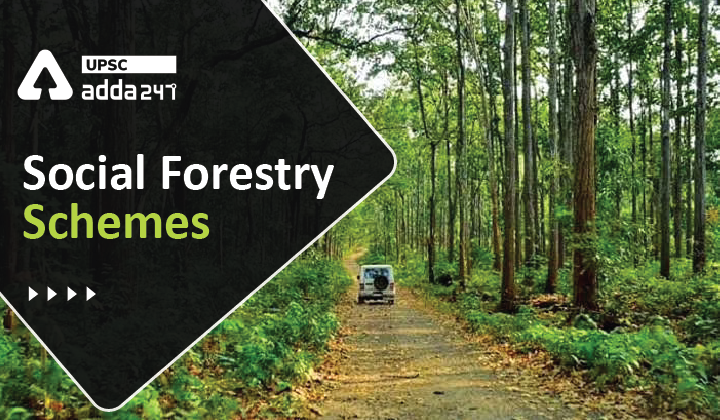Table of Contents
Social Forestry Schemes- Relevance for UPSC Exam
- GS Paper 2: Environment- Conservation, environmental pollution and degradation.

Social Forestry Schemes in news
- The Ministry of Environment, Forest and Climate Change encourages plantation in the country including in various metropolitan cities through Social Forestry programs and Social Forestry schemes.
What is Social Forestry?
- Definition: Social forestry is the management and protection of forests and afforestation of barren and deforested lands with the purpose of helping environmental, social and rural development.
- Background: The term social forestry was first used in 1976 by The National Commission on Agriculture India.
- Key Objective: Social Forestry is a democratic approach to forest conservation and usage, maximizing land utilization for multiple purposes.
- Through Social Forestry, the government of India aims to reduce pressure on forests by planting trees on all unused and fallow lands.
Familial Forestry | Land for Life Award of UNCCD
Social Forestry Schemes
- Various Social Forestry Schemes are-
- Nagar Van Yojana:
- School Nursery Yojana,
- Compensatory Afforestation Fund Management and Planning Authority (CAMPA),
- National Afforestation Programme (NAP), National Mission for a Green India (GIM), etc. which promotes urban forestry, tree plantation on vacant lands and bunds on farmlands, etc. by involving local communities, NGOs, educational institutions, local bodies, etc.
- Nagar Van Yojana: It is initiated for the creation of Nagar Van (city forest) in urban areas over a period of five years at a total estimated cost of Rs.895crore under the National Fund of the Compensatory Afforestation Fund Management and Planning Authority (CAMPA).
- A total of 65 Nagar Van projects in 22 States have been approved for implementation, so far, under NVY.
Social Forestry Schemes in Various Conservation Domains
- For the preservation and protection of forests and wildlife, various laws including the Forest (Conservation) Act 1980, Indian Forest Act, 1927, Wildlife Protection Act 1972, and other central/state laws as applicable to a State/UT, are implemented by the respective State Government /UT Administration.
- The Ministry also provides financial support to the States /UTs under Forest Fire Prevention and Management Scheme for protection against forest fire.
- National Afforestation Programme (NAP) for tree plantation in degraded forests through people’s participation which has been merged with National Mission for a Green India (GIM),
- In addition to other sub-missions, there is a specific sub-mission for enhancing tree cover in urban and peri-urban areas.
- An area of over 2 million hectares was sanctioned for taking up afforestation in the States/Union Territories (UTs) with an investment of about Rs. 3936.41 crores till 2020-21 under NAP since its launching year 2000.
- Under GIM an amount of about Rs. 455 crore has been released to States/UTs from 2015-16 to 2020-21.
- Urban forestry is a permissible activity under the provisions of the Compensatory Fund Act, 2016 and the Rules made thereunder.
- The Government of India has disbursed an amount of Rs. 48606.39crore from National Fund to 32 State funds as a share of respective States as per Compensatory Fund Act, 2016.
- Atal Mission for Rejuvenation and Urban Transformation (AMRUT): 1864 No. of parks over 3794 acres of land have been developed in the Mission cities.
- Tree plantation, being a multi-departmental, multi-agency activity, is also being taken up cross-sectorally under various programs/funding sources of other ministries/ organizations and also through State Plan budgets.
Familial Forestry | Land for Life Award of UNCCD




 TSPSC Group 1 Question Paper 2024, Downl...
TSPSC Group 1 Question Paper 2024, Downl...
 TSPSC Group 1 Answer key 2024 Out, Downl...
TSPSC Group 1 Answer key 2024 Out, Downl...
 UPSC Prelims 2024 Question Paper, Downlo...
UPSC Prelims 2024 Question Paper, Downlo...





